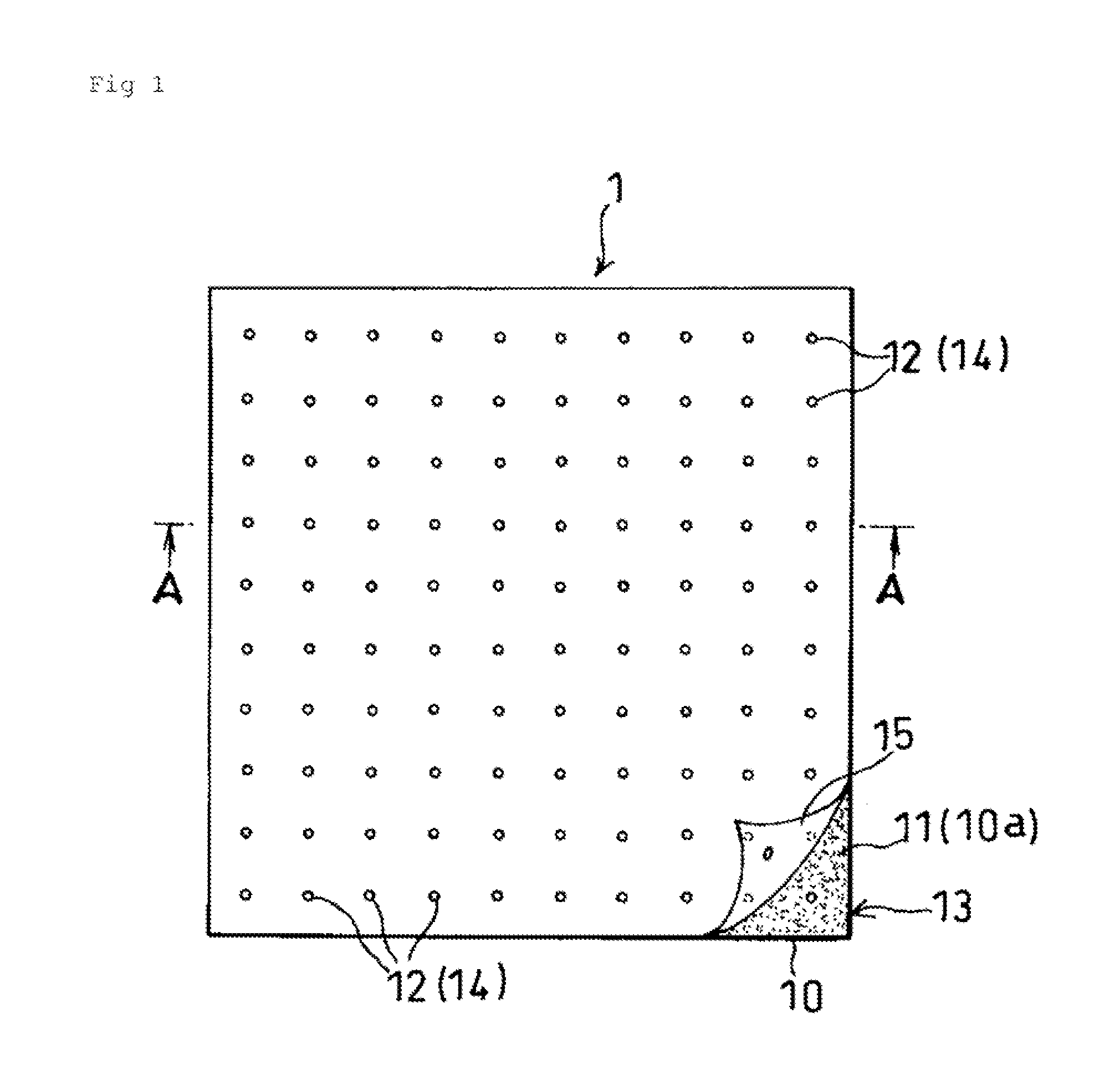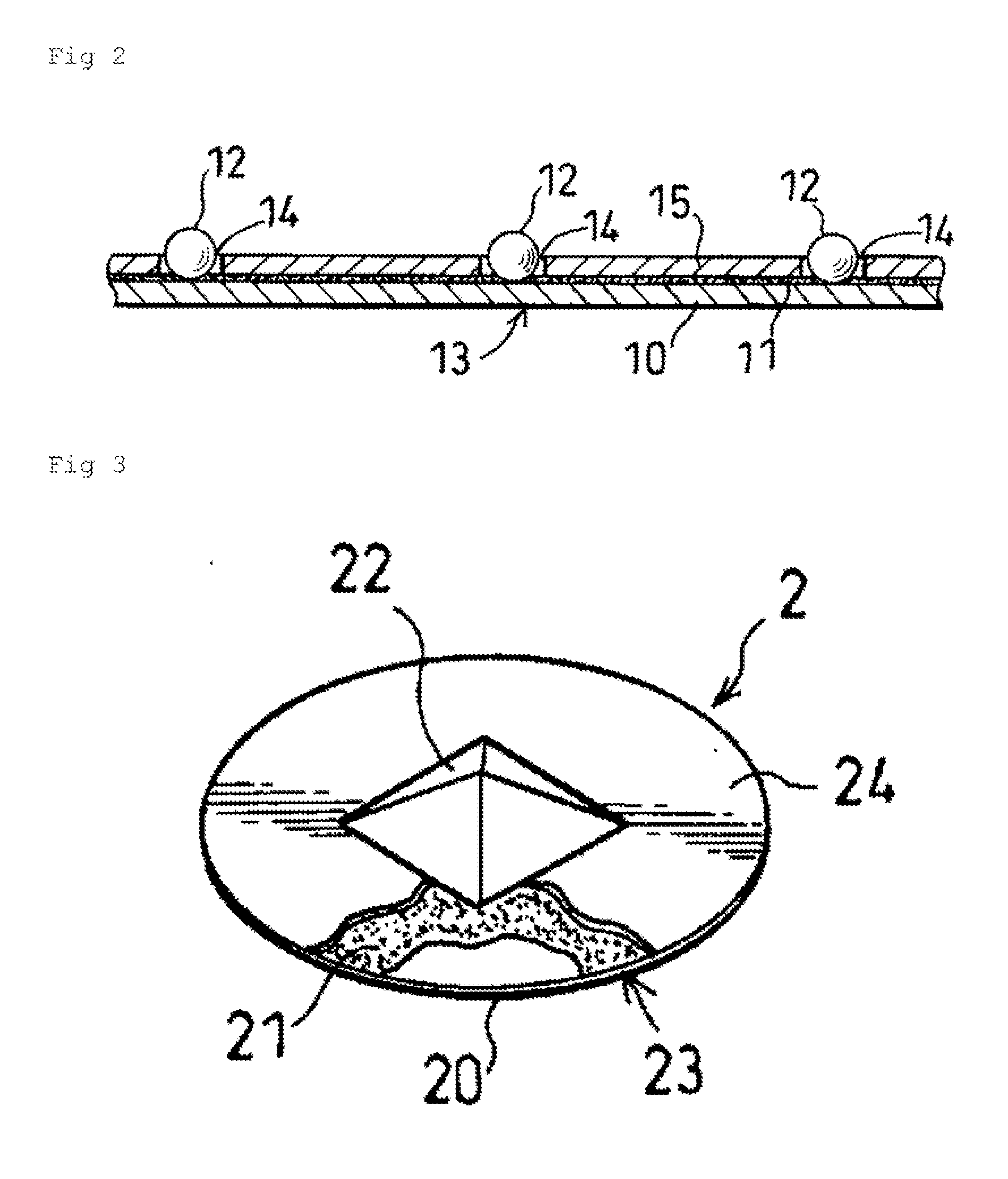Skin Patch Instrument For Treating Pain
a skin patch and instrument technology, applied in the field of therapeutic patches for treating pain, can solve problems such as unthinking treatment with resp
- Summary
- Abstract
- Description
- Claims
- Application Information
AI Technical Summary
Benefits of technology
Problems solved by technology
Method used
Image
Examples
example 1
Clinical Example 1
(Object to be Treated)
[0126]Eighty patients suffering from knee pain (including chronic and acute pain) (average age: 50.9, male / female: 24 / 56) were selected at random and were classified into a metal group (Therapeutic patch B: a gold-plated iron was used as metal in a polygonal pyramid shape with a maximum diameter of 5 mm and a height of 2 mm at the center of a circular sheet of about 3.5 cm), and a non-metal group at random.
(Therapeutic Method)
[0127]The metal group and the non-metal group each included 40 patients suffering from knee pain. Sites to be treated were set to be a tender area and an induration present in the periphery of a knee and a femoral region in both the metal group and the non-metal group. As treatment methods, 10 minutes of low frequency treatment and 10 minutes of massage, and the presence or absence of metal grains were used. In order to evaluate therapeutic effects on knee pain objectively, a therapeutic method was set to be constant. Fur...
example 2
Clinical Example 2
[0132]Table 2 shows the results obtained by conducting treatment for pain in other parts of a body in the same way as in knee pain.
[0133]In the same way as in knee pain, the treatment of attaching metal grains used in the metal group of Clinical Example 1 to the tender area up to a boundary thereof and / or the entire induration was recognized to have a sufficient effect (Table 2). See data difference in significance of 1% and data after the treatment of lumbar hernia.
TABLE 2Therapeutic effects on other painName of diseasePain inLumbarcervicalSciaticaherniapartHeadacheAverage58.7 ± 13.753.6 ± 22.862.3 ± 19.268.8 ± 18.7beforetreatmentAverage after17.3 ± 13.412.3 ± 20.421.2 ± 18.118.0 ± 15.3threetreatmentsSignificantPresentPresentPresentPresentdifference(P (P (P (P group>Average56.5 ± 13.145.5 ± 15.160.2 ± 20.365.5 ± 18.2beforetreatmentAverage after38.4 ± 12.634.3 ± 27.744.5 ± 19.549.3 ± 22.5threetreatmentsSignificantAbsent (—)Absent (—)Absent (—)Absent (—)differenceNa...
example 3
Clinical Example 3
[0134]Prevention of recurrence refers to the elimination of tenderness and the complete flexing of an induration. In the case of an induration, pain is not caused depending upon the use frequency even when the induration is present. This is because pain is not caused as long as an excess load is not applied to an induration part. Further, in the case where strong tenderness remains even if pain (subjective pain) is alleviated, there is a high possibility of recurrence when the treatment is stopped. No recurrence is recognized when no pain is caused by pressing strongly with a bar as well as a finger.
[0135]According to the therapeutic method of the present invention shown in Clinical Examples 4 and 5, a recurrence ratio was 26% (i.e., 7 patients of 27 patients), and a healing ratio was 74% (i.e., 20 patients of 27 patients). This is a remarkable effect, showing a low recurrence ratio, compared with the result in which pain is alleviated in 22.4% of the patients and ...
PUM
 Login to View More
Login to View More Abstract
Description
Claims
Application Information
 Login to View More
Login to View More - R&D
- Intellectual Property
- Life Sciences
- Materials
- Tech Scout
- Unparalleled Data Quality
- Higher Quality Content
- 60% Fewer Hallucinations
Browse by: Latest US Patents, China's latest patents, Technical Efficacy Thesaurus, Application Domain, Technology Topic, Popular Technical Reports.
© 2025 PatSnap. All rights reserved.Legal|Privacy policy|Modern Slavery Act Transparency Statement|Sitemap|About US| Contact US: help@patsnap.com



